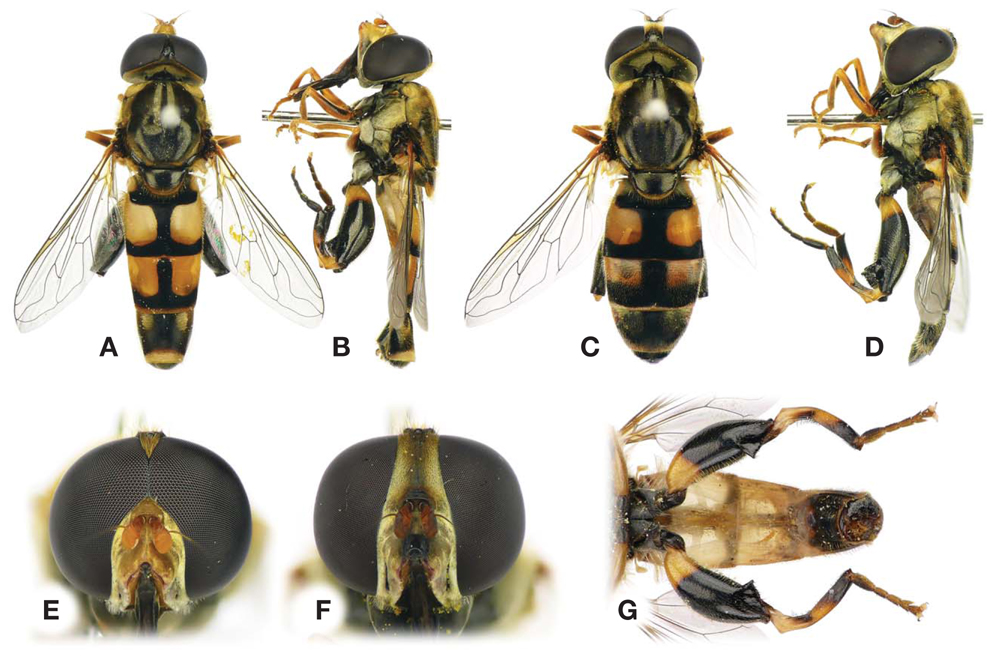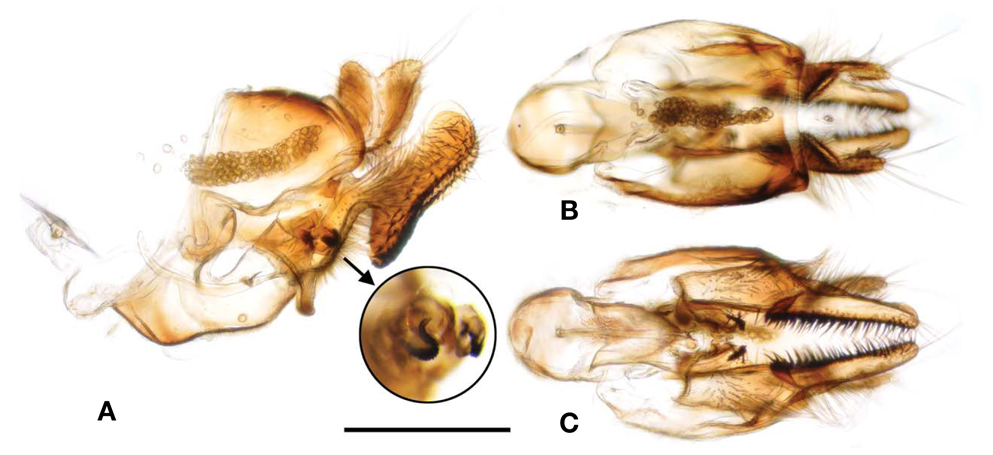



The genus
Based on a series of specimens recently collected in southern part of South Korea (Pohang-si), we here report
The morphological terminology and interpretations follow McAlpine (1981) and Thompson (1999). The two lengths and five ratios used in the descriptions were modified from Han and Norrbom (2005): body length (anterior margin of head excluding antenna to posterior margin of abdomen); wing length (anterior margin of tegular to apex of vein R4+5); face-head ratio (width of face/width of head in dorsal view); eye ratio (shortest eye diameter/longest eye diameter); wing-mesonotum ratio (wing length/mesonotum length); vein R4+5 ratio (distance along vein R4+5 between crossvein r-m and vein R4+5 apex/distance between crossvein r-m and basal node of vein R4+5); and vein M ratio (distance along vein M between crossveins r-m and dm-cu/distance between crossveins r-m and bm-cu).
All the examined Korean specimens are deposited in the Division of Biological Science and Technology, Yonsei University, Wonju Campus, Korea (YSUW). We also examined some Japanese specimens including the holotype of
Order Diptera Family Syrphidae Latreille, 1802 Genus Tropidia Meigen, 1822
>
1*
Material examined. Korea: Chungcheongnam-do: 1♂, Taean- gun, Sowol-myeon, Cheollipo Arboretum, 36°47'55''N, 126°08'59''E, 14 Jun 2007, Choi DS; Gyeongsangbuk-do: 38♂♂, 18♀♀, Pohang-si, Buk-gu, Heunghae-eup, Gokgang- ri, 36°06'51''N, 129°23'37''E, alt. 32 m, 4 Jun 2011, Suk SW et al.; Japan: holotype ♀ of
Diagnosis. This species can be distinguished from other Palaearctic members of the
Redescription of male. Body length 9.5-11.3 mm; wing length 5.6-7 mm. Head (Fig. 1A, B, E) with face-head ratio 0.37-0.39; eye ratio 0.64-0.68; vertex brownish black with yellowish brown pruinosity posterolaterally, with yellowish brown hairs; ocellar triangle brownish black with yellowish brown hairs; ocelli arranged in isosceles triangle; occiput brownish black with pale yellow pruinosity densely, with yellowish brown and some brownish black hairs mixed; frons with heavy yellowish brown pruinosity except for shiny dark brown lower median portion; lower facial margin strongly protrudes forward; frons with heavy yellowish brown pruinosity except for dark brown lower median portion and narrow mid-line upward; gena brownish black with pale yellow hairs; parafacial with yellow microscopic hairs; eyes holoptic, bare; antennal scape and pedicel yellowish brown with brownish black hairs dorsally; flagellomere 1 yellowish brown, bare; arista yellowish brown to dark brown, bare. Thorax (Fig. 1A, B) predominantly brownish black with yellowish brown hairs, with pale yellow pruinosity; scutum shiny black with pale yellow pruinosity laterally except on middle area, anterior 2/3 of scutum with pair of pale yellow submesal longitudinal stripes; notopleuron and postalar callus densely with pale yellow pruinosity; scutellum shiny brownish black in ground color with yellowish brown posteromarginally; postpronotum with pale yellow pruinosity, with lateral 1/3 yellowish brown hairs; anterior anepisternum with grayish pruinosity, bare; posterior anepisternum with grayish pruinosity except for ventral 1/3 area; proepimeron brownish black with grayish pruinosity, bare; katepisternum with large longitudinally elliptic grayish pruinosity dorsally, mostly bare except for yellow hairs on grayish pruinosity; anepimeron and katepimeron with grayish pruinosity; meron with grayish pruinosity, bare; katatergite posteriorly with yellowish brown hairs. Wing (Fig. 1A) entirely microtrichose, mostly hyaline except for pterostigma yellowish brown; cell r1 open to wing margin; crossvein dm-cu and apical crossvein nearly continuous each other; wing-mesonotum ratio 1.71-1.91; vein R4+5 ratio 1.54-2; vein M ratio 0.63-0.8; calypter pale yellow, marginally with yellowish brown hairs; halter yellow. Legs (Fig. 1B, G) predominantly yellowish brown in ground color with some darker areas, with yellowish brown hairs; fore coxa brownish black, posteriorly bare; fore trochanter brownish black (some individuals have brownish black hairs apically); fore femur dorsally with brownish black longitudinal stripe except for basal and apical areas, ventrally with similar stripe at apical 1/2; apical 1/4 of fore tibia brownish black; fore tarsus with some brownish black hairs apically; mid coxa brownish black, anteriorly with long yellowish brown hairs, posteriorly bare; midfemur both dorsally and ventrally with brownish black longitudinal stripes at apical 1/2; midtarsus with some brownish black hairs apically; hind coxa brownish black with pale yellow pruinosity, posteriorly bare; hind trochanter brownish black (some individual brownish black hairs mixed); apical 3/4 of hind femur brownish black, swollen with large subapical ventral triangular process (this process covered with brownish black spine-like hairs posteriorly); hind tibia strongly curved dorsally at basal 1/3, with subbasal dorsal tubercle, with apex ventrally pointed, yellowish brown with apical 1/3 entirely brownish black, with brownish black ventral spot at basal 1/3, also with brownish black hairs ventrally; hind tarsus brownish black dorsally, yellowish brown ventrally. Abdomen (Fig. 1A, B, G) conical shape with preabdominal tergites brownish black in ground color with brownish yellow spots laterally, with brownish black hairs except on yellowish brown areas yellowish brown hairs; tergite 1 entirely brownish black with brownish black hairs posteromarginally; tergite 2 with pair of elongated square yellowish brown spots (about 4/5 as long as tergite length); tergite 3 with elongated square spots (slightly fused anteriorly; about 4/5 as long as tergite length) and with narrow brownish yellow posteromarginal band; tergite 4 predominantly brownish black with small triangular yellowish brown spot anterolaterally; also with round grayish sublateral pruinose spots right next to yellow spots; sternites 1, 4, 5 brownish black, and sternites 2-3 brown; all preabdominal sternites covered with yellowish brown hairs. Genitalia (Fig. 2A-C; coloration faded due to KOH treatment) nearly dark brown; epandrium rounded dorsally in lateral view with brown hairs; cercus more or less reverse triangular in lateral view with transverse constriction; in lateral view, sustylus constricted medially and widened greatly apically; sustylus with long dense hairs basally and shorter and recumbent hairs apically; superior lobe (sensu Thompson, 1999) S-shaped with regular transvers serrations, strongly sclerotized; aedeagus simple tube shape, concealed by superior lobes.
Female. Similar to male except for the following non-genitalic characters (Fig. 1C, D, F): frons and face with brownish black transverse mid-stripe; eyes dichoptic. Abdomen narrowly oval shape; tergite 2 and 3 similar to those of males but dark area 1.5-2× as wide; tergite 4 with similar antero-lateral triangular yellowish brown spots but grayish pruinosity spots covering almost twice as long and wide areas; tergite 5 dark brown, barely seen in dorsal view. Lengths and ratios: body length 9.2-10.5 mm; wing length 5.5-7.1 mm; facehead ratio 0.29-0.37; eye ratio 0.59-0.75; wing-mesonotum ratio 1.77-1.89; vein R4+5 ratio 1.64-1.82; vein M ratio 0.64 -0.86.
Distribution. Korea, Japan, Russian Far East, China.
Remarks. Shiraki (1930) originally described this species based on the single holotype female, but Shiraki (1968) somehow erected a new genus and species,

